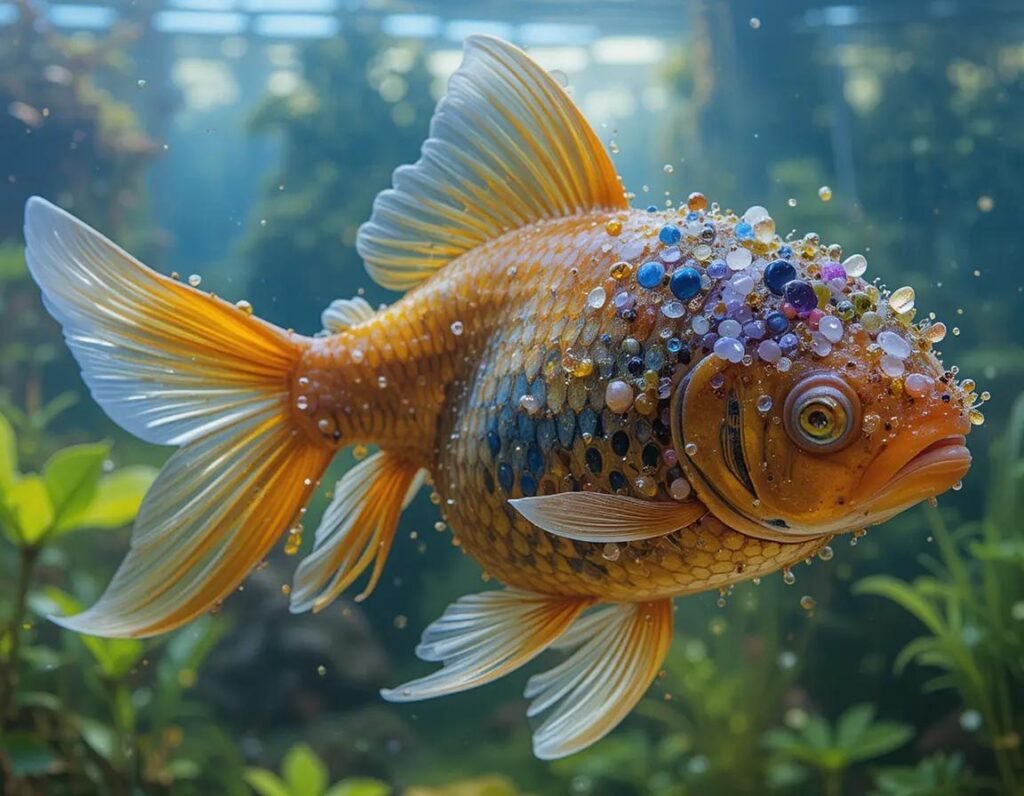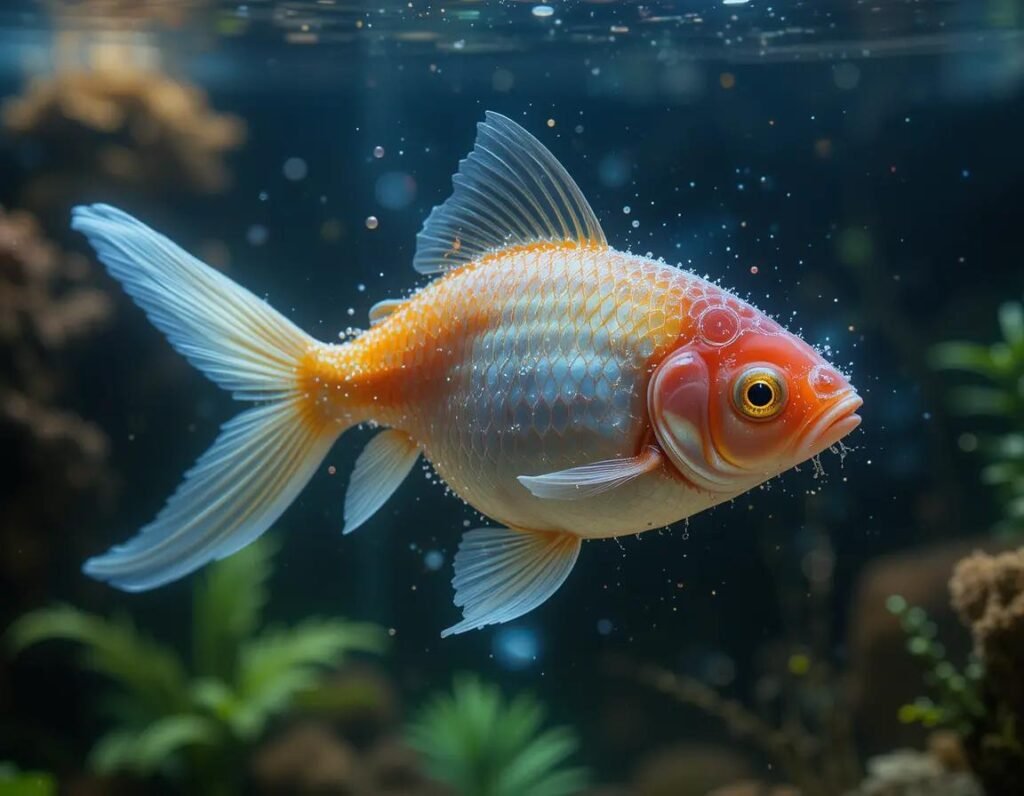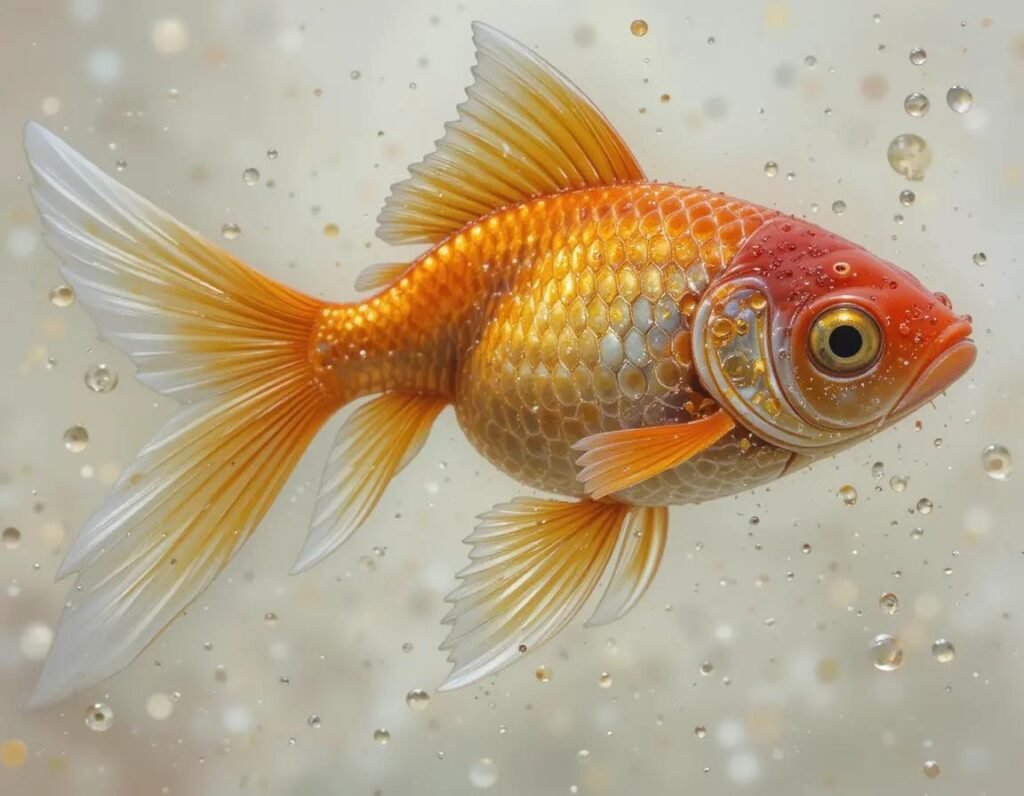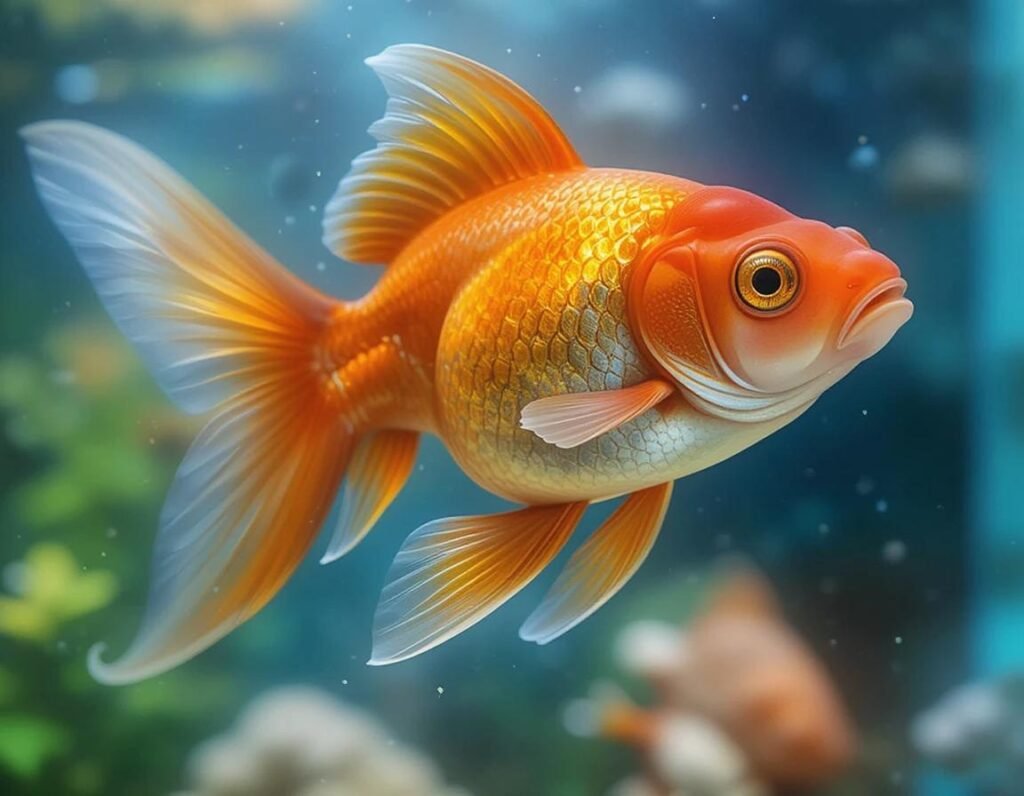
Goldfish are some of the most popular pets around, thanks to their calm nature and beautiful, flowing fins. But, like any pet, they can fall ill. And when they do, it’s important to act quickly. Goldfish diseases might sound scary, but don’t worry—most can be easily treated if you catch them early! In this article, we’ll dive into the most common goldfish diseases, how to spot them, and what you can do to help your aquatic friend swim back to health. And don’t worry, we’ll keep it simple. No need for a Ph.D. in fish biology here!
1. Ich (White Spot Disease)
Let’s kick things off with a real classic: Ich. You’ve probably heard of it because it’s one of the most common goldfish diseases around. This sneaky parasite shows up as tiny, white, salt-like spots on your goldfish’s skin, fins, and gills. If you’re wondering, “Is that goldfish covered in sugar?”, no—it’s Ich.
Symptoms:
- White spots on the body and fins (looks like they’ve been sprinkled with salt)
- Scratching against tank decorations (they’re itchy!)
- Rapid gill movement or labored breathing
Treatment:
- Increase water temperature (but not too hot—goldfish like it cool!)
- Use an Ich treatment available at pet stores (like copper sulfate-based products)
- Improve water quality (because a clean tank is a happy tank)
A warm bath and a clean tank should do the trick, but make sure you keep an eye on your fish. If you notice a decrease in appetite or lethargy, that could be a sign it’s time to step up your treatment.
2. Fin Rot
Fin Rot is the goldfish equivalent of a bad hair day. You might notice that your goldfish’s fins look ragged, torn, or even discolored. It’s caused by bacterial infections that thrive in dirty water, and it can happen if your tank isn’t properly maintained.
Symptoms:
- Frayed or ragged fins
- Discoloration or black edges on fins and tails
- Fish rubbing against objects to relieve pain
Treatment:
- Quarantine the sick goldfish to prevent spreading the infection
- Clean the tank and check water quality regularly
- Use an antibacterial treatment (can be found at pet stores)
Fin rot is pretty easy to treat with proper care, but make sure you don’t delay! The faster you catch it, the less damage will occur to those beautiful fins.
3. Dropsy (Swollen Belly)
Dropsy is a sneaky condition that causes fluid to build up inside your goldfish, making them appear bloated and swollen—kind of like they’ve eaten a giant fish-sized meal and never quite digested it. In severe cases, this can be deadly, but don’t panic just yet!
Symptoms:
- Swollen belly (the fish looks like a little balloon)
- Scales sticking out (this is often referred to as “pinecone” appearance)
- Lethargy or lack of appetite
Treatment:
- Check water quality—Dropsy is often linked to poor water conditions.
- Quarantine the affected fish and remove uneaten food from the tank.
- Use antibiotics or consult your vet for specific treatment options.
Dropsy can be tricky because it’s often a symptom of something more serious, like an organ failure or bacterial infection. If you spot it early, there’s a good chance your fish can recover with some TLC.
4. Swim Bladder Disorder
Swim bladder issues are a common problem for goldfish, especially the ones with fancy, round bodies (we’re looking at you, Orandas). This disease affects the goldfish’s ability to float properly, leading them to swim upside down, sideways, or even struggle to stay off the bottom of the tank.
Symptoms:
- Floating upside down or on their side
- Difficulty swimming to the surface or sinking
- Loss of appetite or lethargy
Treatment:
- Stop overfeeding—goldfish are great eaters, but overeating can lead to swim bladder problems. Stick to small portions and avoid feeding them right before bed.
- Maintain clean water—good filtration and water changes can help keep things in balance.
- Add peas to their diet! Boiled peas (with the skins removed) can help clear up constipation, which often causes swim bladder issues.
A little moderation in feeding and water care can usually do the trick. If the issue persists, you might need to consult a vet, especially if your fish isn’t getting better.

5. Velvet Disease (Gold Dust Disease)
If your goldfish starts looking like it just rolled in some glitter, it might have Velvet Disease. This disease is caused by a protozoan parasite, which forms a golden, dust-like coating on the fish’s body. It’s not as cute as it sounds!
Symptoms:
- Gold or rust-colored dust on the skin
- Scratching against objects (itchy, itchy, itchy!)
- Labored breathing or rapid gill movement
Treatment:
- Raise the water temperature (again, not too hot—remember, goldfish like it cool)
- Treat with copper sulfate or formalin-based medications
- Perform water changes and ensure your filter is working well
It’s a bit of a hassle, but with the right medication and proper water conditions, velvet disease can be treated fairly easily.
6. Flukes and Worms (External Parasites)
External parasites like flukes and worms are a real nuisance for goldfish. These pesky creatures attach to the skin, gills, and fins of the fish, causing irritation and discomfort.
Symptoms:
- Rubbing against objects (again, itchiness)
- Gasping or abnormal breathing
- Cloudy or swollen eyes
Treatment:
- Use an anti-parasitic treatment (usually available at pet stores or online)
- Perform water changes and check filter for proper functioning
If your goldfish is dealing with these external parasites, a proper medication and good tank care will help eliminate the issue.
7. Anchor Worms
Anchor worms are another unwelcome parasite that can make your goldfish’s life miserable. These tiny worms burrow into the skin, attaching themselves like little anchors, causing irritation and sometimes swelling. If your goldfish is scratching at the rocks or plants more than usual, it could be dealing with this creepy-crawly problem.
Symptoms:
- Visible worms sticking out of the fish’s body (yikes!)
- Red or inflamed areas where the worms attach
- Excessive rubbing against objects
Treatment:
- Remove the visible worms carefully with tweezers (don’t hurt the fish!)
- Use a medicated bath designed for anchor worms or anti-parasitic treatment available at pet stores.
- Maintain excellent water quality to help your fish recover more quickly.
If left untreated, anchor worms can cause infection, so it’s essential to act fast. Keeping your water clean and checking your fish regularly will help prevent future outbreaks.
8. Skin Erosion (Ulcers)
Skin ulcers, or erosion of the skin, often result from a bacterial infection that causes sores or wounds on your goldfish’s body. It can happen if there’s a tear or scratch in the skin, or if the water quality isn’t top-notch.
Symptoms:
- Visible sores or ulcers on the skin
- Cloudy or inflamed patches
- Loss of appetite or lethargy
Treatment:
- Isolate the affected fish to prevent spreading any potential infection
- Treat the wound with antibacterial medication specifically designed for fish
- Maintain perfect water conditions to speed up healing
Skin erosion can be severe, but with proper care, most goldfish can recover. Always ensure your water filter is functioning properly and do regular water changes to keep infections at bay.
9. Lice (Fish Lice)
Fish lice are another external parasite that can affect your goldfish. These little critters latch onto the fish’s skin and gills, causing irritation and sometimes even secondary infections.
Symptoms:
- Visible lice (tiny white or grayish spots) on the skin, fins, or gills
- Excessive scratching or rubbing against surfaces
- Gasping or rapid breathing due to gill irritation
Treatment:
- Use anti-parasitic treatments available at most pet stores
- Regularly clean the tank and perform water changes
- Use a quarantine tank for infected fish to stop the lice from spreading
Like other external parasites, lice can be a hassle, but with the right treatment, your goldfish will soon be back to its happy, shiny self!
10. Costia
Costia is another protozoan parasite that can cause skin irritation, lesions, and even respiratory problems for goldfish. It’s known for its “skin burns” appearance and can often lead to a lot of stress for the affected fish. While it’s not as common as some other goldfish diseases, it’s still something to watch out for.
Symptoms:
- Mucus-like film or slimy coating on the skin
- Loss of appetite or lethargy
- Rubbing or scratching against objects
- Rapid breathing
Treatment:
- Salt baths can help treat the infection by killing off the parasites.
- Use anti-parasitic medication specifically designed to treat Costia.
- Perform regular water changes to improve the water quality.
The good news is that Costia is treatable with prompt care, but the bad news is it’s a little tricky to diagnose on your own. If you suspect Costia, a visit to an aquatic vet might be your best bet.
Preventing Common Goldfish Diseases
It’s clear that prevention is the key when it comes to keeping your goldfish happy and healthy. But how can you prevent all these diseases from popping up in the first place? Here are some tips to ensure your goldfish stays in tip-top shape:
- Maintain clean water: Regular water changes, proper filtration, and checking water parameters (temperature, pH, ammonia levels) will keep your goldfish thriving.
- Don’t overfeed: Goldfish love to eat, but overfeeding can lead to health problems like swim bladder issues and poor water quality. Stick to feeding small amounts 1-2 times per day.
- Quarantine new fish: If you’re adding new goldfish to your tank, quarantine them for a few weeks first to make sure they’re not carrying any diseases.
- Invest in good filtration: Goldfish produce a lot of waste, so your filtration system should be able to handle it. Aim for a filter rated for a tank at least 2-3 times the size of your actual tank.
- Provide a stress-free environment: Stress is a major contributor to fish illnesses. Keep your goldfish’s environment calm with low light, no sudden movements, and tank mates that aren’t too aggressive.
Conclusion
Goldfish are wonderful, low-maintenance pets—but like any living creature, they can run into a few bumps (or spots) along the way. The good news is that most common goldfish diseases are preventable and treatable with the right care. By keeping a close eye on water quality, watching out for strange behaviors, and reacting quickly when you spot symptoms, you can ensure your goldfish stays happy, healthy, and swimming happily in their tank. Plus, with a little knowledge in your back pocket, you’ll be the goldfish health expert of the neighborhood. Who knew being a goldfish doctor could be so fun?
Common Goldfish Diseases FAQs:
1. What are the most common goldfish diseases?
Answer: Some of the most common goldfish diseases include:
- Ich (White Spot Disease): A parasitic infection that causes white spots on the skin.
- Fin Rot: Caused by bacteria, it leads to ragged, discolored fins.
- Dropsy: Swelling and fluid retention that gives your goldfish a bloated appearance.
- Swim Bladder Disorder: Causes difficulty in swimming, often seen when goldfish have trouble staying upright.
- Velvet Disease: A golden, dust-like coating on the skin caused by a protozoan parasite.
- Anchor Worms: Tiny worms attaching to the skin, causing irritation.
- Skin Erosion (Ulcers): Bacterial infections that cause wounds on the fish’s body.
- Lice: External parasites that cause itching and irritation.
- Costia: A protozoan parasite that causes skin burns and respiratory problems.
2. How can I tell if my goldfish is sick?
Answer: Sick goldfish will often display abnormal behavior such as:
- Loss of appetite
- Lethargy or weakness
- Rubbing against objects
- Abnormal swimming (like floating upside down or struggling to swim)
- Visible signs like spots, ulcers, or swollen body
- Rapid or labored breathing
If you notice any of these signs, it’s important to take action quickly!
3. How do I prevent goldfish diseases?
Answer: Prevention is all about keeping your tank clean and maintaining good water quality:
- Regular water changes and filter cleaning
- Properly quarantine any new fish before adding them to your tank
- Don’t overfeed—feeding in moderation helps avoid digestive issues
- Use a good quality filter that’s appropriate for the size of your tank
- Monitor the water temperature and pH levels
- Keep an eye on your goldfish’s behavior and look out for any changes
4. Can I treat goldfish diseases at home?
Answer: Yes! Many goldfish diseases can be treated at home with the right medications or adjustments:
- Ich: Increase water temperature and treat with an anti-Ich medication.
- Fin Rot: Improve water quality and treat with antibacterial medicine.
- Dropsy: Isolate the fish and treat with antibiotics or improve water conditions.
- Swim Bladder Disorder: Limit food, offer peas, and adjust water temperature.
- Velvet Disease: Treat with copper sulfate or other parasitic medications.
Always make sure to consult a vet or aquatic specialist if you’re unsure about how to treat the illness.

5. Why is my goldfish scratching against objects?
Answer: Scratching is often a sign that your goldfish has itchy skin, which could be caused by parasites (like Ich or Velvet disease) or skin abrasions. If you see this behavior, it’s a good idea to check for visible parasites and treat with appropriate medications.
6. What should I do if my goldfish has Dropsy?
Answer: Dropsy often indicates a serious internal issue, such as organ failure or infection. You can:
- Isolate the sick fish
- Maintain perfect water quality (test pH, ammonia, nitrite, and nitrate levels)
- Consult a vet for specialized treatment (such as antibiotics or anti-bacterial meds)
If the symptoms are severe, unfortunately, the prognosis may not be great, but early intervention can make a big difference.
7. Can goldfish get diseases from other fish?
Answer: Yes, goldfish can catch diseases from other fish, especially if they are kept in the same tank. It’s always a good idea to quarantine any new fish for a few weeks before introducing them to your main tank to prevent disease outbreaks.
8. Is velvet disease contagious to other fish?
Answer: Yes, velvet disease is highly contagious. If one fish is infected, it can quickly spread to others in the same tank. It’s crucial to isolate the infected goldfish and treat the tank with anti-parasitic medication to prevent the spread.
9. How do I treat fin rot in goldfish?
Answer: Treating fin rot involves:
- Improving the tank’s water quality with regular water changes
- Using antibacterial medication to treat the infection
- Isolating the sick fish to prevent further spread of the bacteria
If left untreated, fin rot can lead to more serious issues, so it’s important to take action as soon as possible.
10. Can poor water quality cause goldfish diseases?
Answer: Absolutely! Poor water quality is the leading cause of most goldfish health problems. High levels of ammonia, nitrites, and nitrates can weaken your fish’s immune system, making them more susceptible to diseases. Regular water changes, proper filtration, and monitoring of water parameters are essential for preventing most common goldfish diseases.


